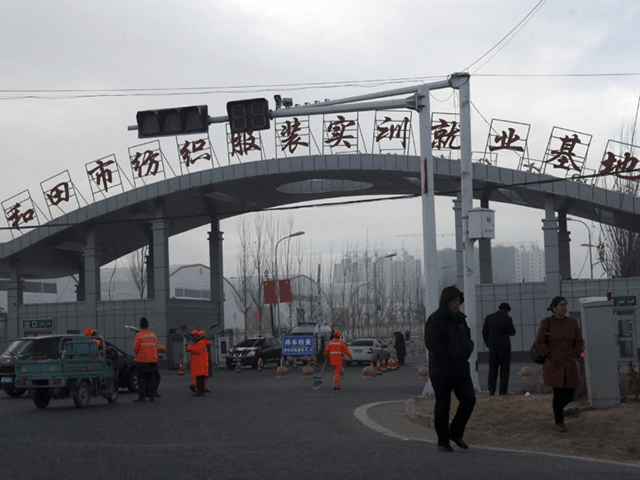China’s northwestern city of Hotan recorded “the worst average air quality” in the world in 2020, India’s Business Standard newspaper reported Tuesday citing data from the air quality tracker IQAir.
Hotan is located in a western Chinese region notorious for an extensive concentration camp system. Multiple world governments, including the administration of President Joe Biden, have deemed China’s actions against the ethnic minority Uyghur people there a genocide.
The IQAir tracker, which measures harmful fine particulate matter (PM2.5) in the atmosphere, ranked Hotan as number one on its index of most polluted cities in 2020. Hotan posted an average PM2.5 rating of 110.2 for 2020.
“Particulate matter contains microscopic solids or liquid droplets that are so small that they can be inhaled and cause serious health problems,” according to the United States Environmental Protection Agency (EPA).
“Some particles less than 10 micrometers in diameter can get deep into your lungs and some may even get into your bloodstream,” the EPA states on its website. “Of these, particles less than 2.5 micrometers in diameter, also known as fine particles or PM2.5, pose the greatest risk to health.”
Hotan is located in East Turkistan, officially called the “Xinjiang Uygur Autonomous Region (XUAR)” by Beijing. Xinjiang is China’s westernmost and largest province. It borders Central Asia generally and is home to minority ethnic groups within China including Uyghurs, who are predominantly Turkic-speaking, Sunni Muslims. Other ethnic minority groups in Xinjiang include Kazakhs and Kyrgyz people. Xinjiang is a strategically significant region neighboring several other countries including Russia and India.
Uyghurs and others from the area consider East Turkistan a separate nation from China under occupied rule. Human rights organizations and foreign governments, such as that of the U.S., estimate that 1 to 3 million ethnic minority people in China’s Xinjiang region — mainly Uyghurs, but also Kazakhs and Kyrgyz people — have been incorporated into state-run concentration camps since about 2017. Ex-employees and former detainees of the concentration camps allege to have either witnessed or endured physical and sexual abuse, torture, forced abortions, and forced sterilizations while in the system.
IQAir’s 2020 World Air Quality Report indicates that at least one of Xinjiang’s cities, Hotan, has recently suffered not just from forced labor camps but also from the most intense pollution in the world.
Environmentalists in the United States have often paired alleged discrimination with climate issues under the label of “environmental racism.” The far-left U.S. Senator Elizabeth Warren (D-MA) has loosely defined the term by citing studies that allegedly suggest “black and Hispanic families are disproportionately affected by air pollution caused by white people.”
“We need a government that’s on the side of families—not giant corporations polluting our communities. @RashidaTlaib and I walked through 48217, the most polluted zip code in Michigan, and talked with the families living every day with the effects of pollution,” Sen. Warren said in a Twitter video posted on October 8, 2019.
While Sen. Warren and most other far-left politicians in the U.S. have continued to promote “environmental racism” propaganda since 2019, they have largely remained silent on the alleged phenomenon as it pertains to China.
Nine out of the ten most polluted cities in the world last year, in terms of air quality, were located in India.
“In 2020, India had 46 of the world’s 100 most polluted cities, followed by China (42), Pakistan (6), Bangladesh (4), Indonesia (1), and Thailand (1),” Al Jazeera reported on November 22 citing IQAir data.
“All these cities had a PM2.5 air-quality rating of more than 50,” Al Jazeera noted.
Ghaziabad, India, ranked as the world’s number two most polluted city in the world in 2020 averaging a PM2.5 rating of 106.6. Delhi, India, rounded out the top ten smoggiest cities in 2020 according to the IQAir tracker with an average PM2.5 output of 84.1.
The city of Delhi serves as India’s National Capital Territory (NCT). The densely populated urban center is home to nearly 32 million people. Delhi endures constant smog from heavy factory and vehicle emissions. The capital battles seasonal upticks in air pollution each winter when agricultural fires in the region exacerbate the city’s smog. Delhi was forced to order all schools in the metropolis to close for a week from November 15 through November 22 due to worse than usual air pollution.
Delhi’s Air Quality Index (AQI), which measures PM2.5 in the atmosphere, “hit 470-499 on a scale of 500” in recent days, Asian News International (ANI) reported on November 15.

COMMENTS
Please let us know if you're having issues with commenting.